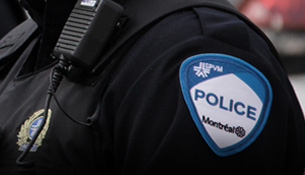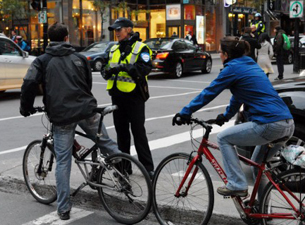
Traffic Rules for Cyclists
Also read
When can a cyclist cross an intersection?
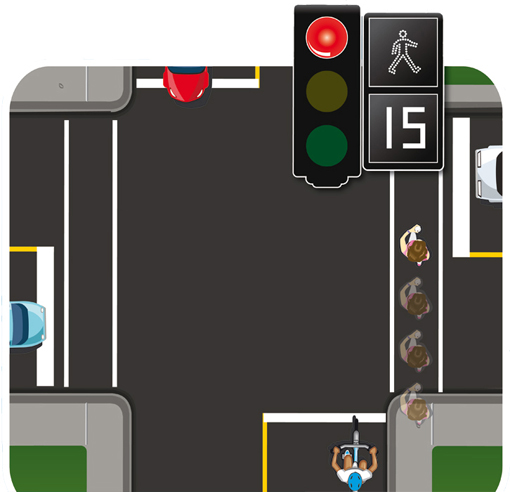
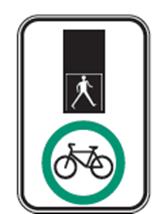 On a red light, a cyclist must stop and wait for the green or the pedestrian signals before advancing.
On a red light, a cyclist must stop and wait for the green or the pedestrian signals before advancing.
If there is no pedestrian signals, cyclists must obey the traffic signals, like all other vehicles.
How should a cyclist make a left turn?
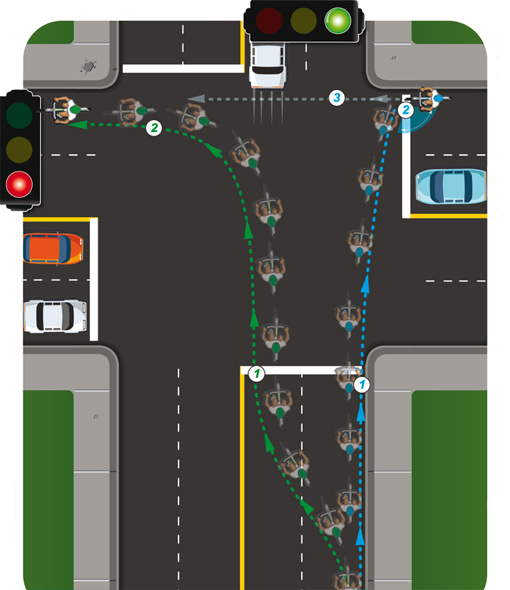
They are two ways a cyclist can make a left turn
Like a pedestrian
- Cross the intersection on the green light
- On the opposite corner, turn and get in position to ride in the new direction
- Cross when the traffic light turns green
Like a road vehicle
- Get in the left lane
- Make the turn on the green light and move to the far right of the road
Turning at an intersection: should drivers yield to cyclists who are going
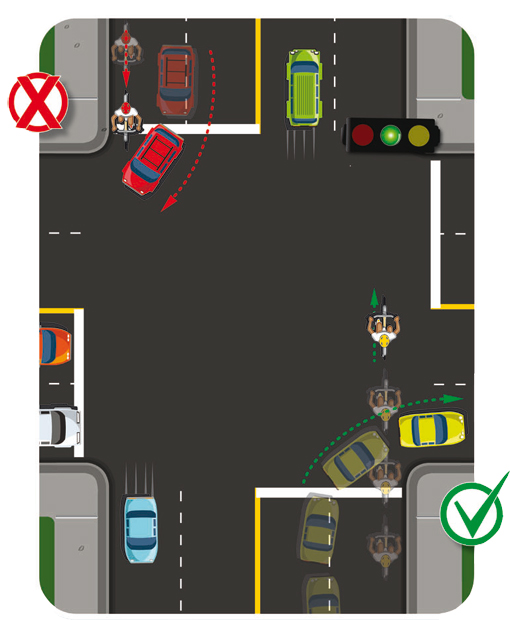
Yes.
When turning at an intersection, drivers of motor vehicles must yield the right of way to cyclists who want to go straight through (Article 349 of the Highway Safety Code).
At a red light: Can cyclists turn left?
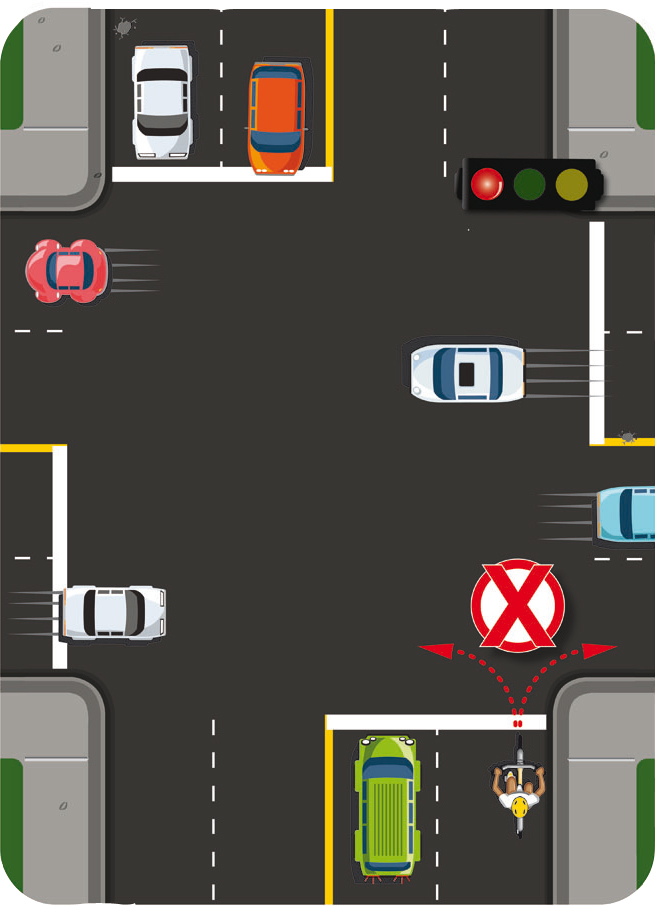
No.
When cyclists come to a red light, they must stop before the pedestrian crosswalk or the stop line or, if there is none, at the near side of the roadway. They may not continue until they receive a signal to proceed. (Article 359 of the Highway Safety Code.)
in summary, cyclists must comply with the same rules of the road that bind motor vehicle drivers, except for the following restrictions:
- A cyclist must ride as close as possible to the edge or right side of the roadway and in the same direction as traffic
- They must ride in single file when in groups of two or more
Infractions and penalties
|
Not respecting these rules constitutes a violation |
Penalties plus applicables fees |
|
Red light Unless otherwise indicated and unless a pedestrian signal is on, when approaching a red light, cyclists must stop before the pedestrian crossing or the stop line; if there is none, they must stop in front of the lateral line on the road at the intersection. They can carry on as soon as the signal changes. |
$80 to $100 (Article 359) |
|
Obligatory stop At an intersection regulated by stop signs installed for only one roadway, the driver of a road vehicle or a cyclist who is facing a stop sign must stop his vehicle and yield the right of way to pedestrians and cyclists crossing or walking or cycling alongside the roadway he is about to cross or enter. |
$80 to $100 (Article 369) |
|
Yielding the right of way A bicycle rider turning in an intersection must yield passage to other pedestrians and cyclists. |
$80 to $100 (Article 349)
|
|
Riding with the flow of traffic and as close as possible to the edge A cyclist must ride as close as possible to the edge or right side of the roadway and in the same direction as traffic, taking into account the condition of the roadway and the risk of car dooring. A cyclist may also ride on the shoulder in the same direction as traffic. The first paragraph does not apply to a cyclist about to make a left turn, if he is authorized to ride against traffic or in case of necessity |
$80 to $100 (Article 487) |
|
Earphones Bicycle riders cannot wear ear-phones while riding. |
$80 to $100 (Article 440) |
|
Riding on the sidewalk A cyclist may not ride a bicycle on a sidewalk except in case of necessity or where directed or allowed to do so by a sign or signal. In such a case, the cyclist must ride at a safe, reasonable speed and give pedestrians the priority
|
$80 to $100 (Article 492.1) |
|
Riding between two lanes of vehicles A cyclist cannot ride between two adjacent lanes of vehicles except when the line in which the cyclist is travelling is contiguous to a line reserved for right turns. |
$80 to $100 (Article 478) |
|
Riding in single file Bicycle riders that travel in groups of two or more must ride in single file. Groups may not consist of more than 15 cyclists. |
$80 to $100 (Article 486) |
|
Compliance with signals The driver of a bicycle must conform to any and all road signals. |
$80 to $100 (Article 488) |
|
Reflectors All bicycles must have at least: 1 - A white reflector in front 2 - A red reflector in back 3 - A amber or white reflector on each pedal 4 - On the front wheel, an amber or white reflector attached to the spokes and visible on both sides of the bicycle, an amber or white reflective strip attached to each side of the fork, a tire with reflective sidewalls or a rim with a continuous reflective strip around the entire circumference of the wheel on both sides 5 - On the back wheel, a red or white reflector attached to the spokes and visible on both sides of the bicycle, a red or white reflective strip on each seat stay, a tire with reflective sidewalls, or a rim with a continuous reflective strip around the entire circumference of the wheel on both sides |
$80 to $100 (Article 232) |
|
Lights at night All bicycles must have at least one white headlight in front and one red light in the back. |
$80 to $100 (Article 233) |
Specifications on certain rules
Riding against traffic
The Highway Safety Code (HSC) stipulates that, unless otherwise authorized, cyclists must ride in the same direction as traffic.
Contrary to pedestrians who are required to walk against traffic in the absence of a sidewalk, cyclists must ride in the same direction as road vehicles.
Drivers have less time to notice cyclists riding against traffic, as the bicycle approaches more quickly.
Drivers at cross roads or exiting a private property do not expect to face a cyclist riding against traffic.
In the event of a head-on collision between a bicycle and a car, the impact will be greater because both speeds—that of the car and that of the bicycle—are combined.
Cyclists riding against traffic become more vulnerable when they pass cyclists riding in the same direction as traffic.
Riding on the sidewalk
The Highway Safety Code (HSC) prohibits cyclists from riding on the sidewalk except in cases of necessity or where there are signs permitting or prescribing this.
It is important to respect the different sidewalk users. For their safety and comfort, walk next to your bicycle if you need to use the sidewalk to get to a business or to your home.

